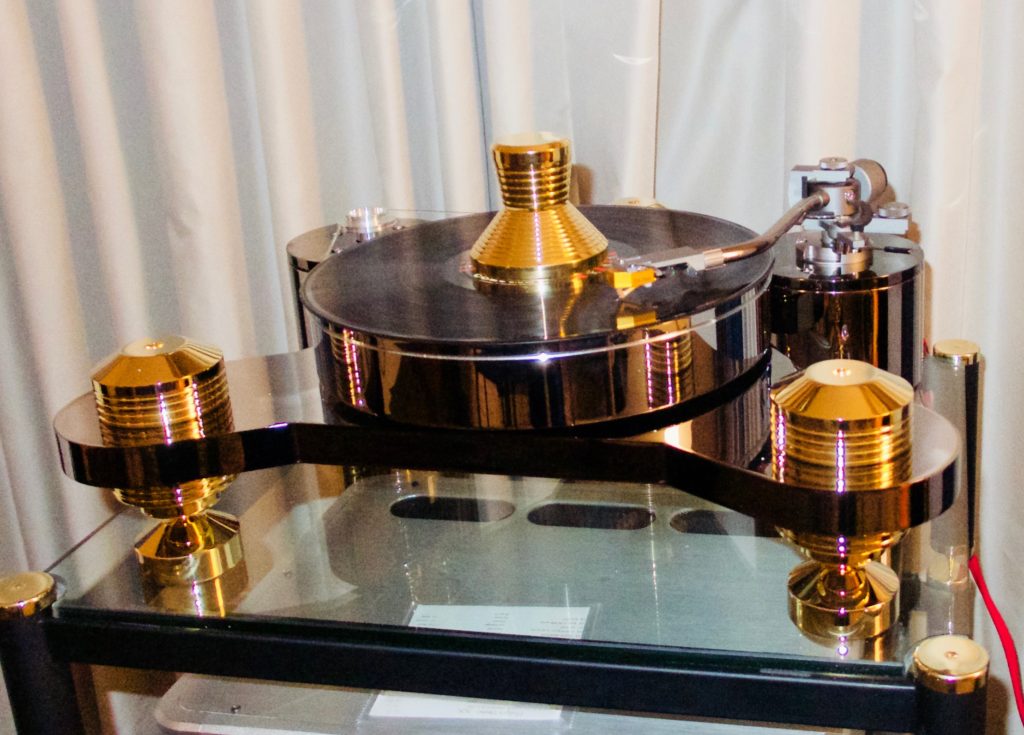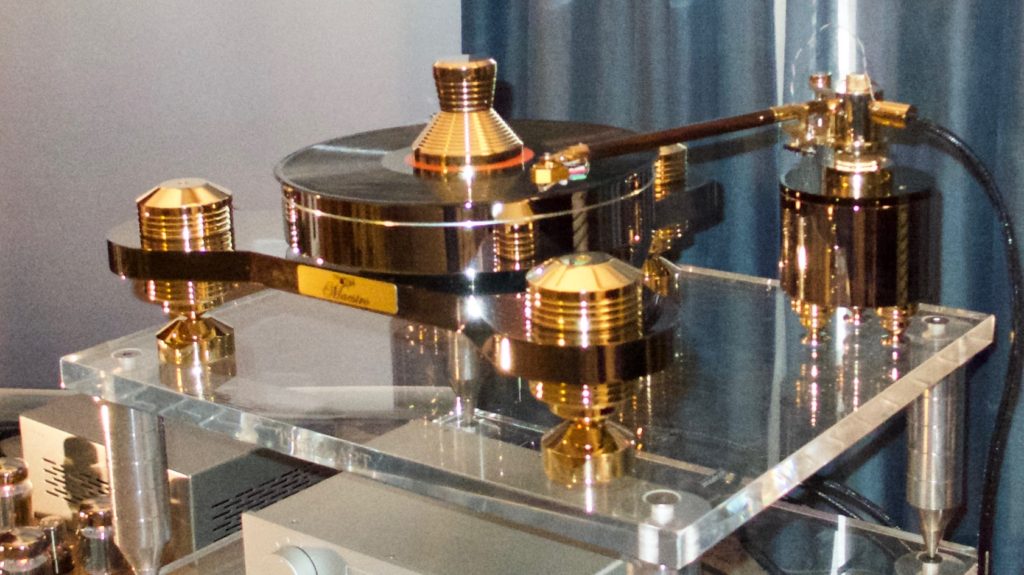
This is my third TriangleArt turntable to review. I’ve reviewed the Symphony, the Symphony SE and now the Maestro. The two Symphony turntables have been discontinued, and the Maestro has taken the place of both. All three turntables have had a few things in common. They all are eye-catching, they are all high mass designs, and they have all sounded great.
I thought the Symphony SE was one of the best turntables I had ever used, so I asked Tom Vu, the founder of TriangleArt. He said the Symphony SE’s biggest problem was how much it weighed. It wasn’t modular, so to set it up, someone had to lift the whole 200-pound turntable.
Description
On its website, TriangleArt lists six turntables that they manufacture in Anaheim, CA. The Maestro is their newest table. On their website, they say the design employs the same philosophy as its big brother, the Reference SE, with the characteristic massive weight. It comes with a hefty, composite metal 1-inch thick Plinth and a 2-inch thick composite metal platter to control all vibrations and provide superior resonance. The stainless-steel bearing is composed of a hardened Titanium shaft with a large ground radius that runs on a thrust washer. The hardened Titanium is a special material with a very low coefficient of friction and very high wear resistance, providing a long, maintenance-free life.
Although the Maestro shares the design philosophy of the Reference SE in that it looks very similar and shares the same footprint, it has just one level and one platter. Still, it weighs in at 80 lbs. It uses an AC motor with a stabilizer, and it can be played at 33 or 45. The TriangleArt Crystal Digital Speed Controller is a $2,800 option that I used in the review. I also used the TA-1 Records clamp that is a $1,200 option.
Setup and Reference system
TriangleArt ships the turntable ready for you to set up your tonearm, which is very simple and straightforward. I removed my turntable from my reference system and set up the Maestro on my Box Furniture Audio Rack. I first set it up without the Crystal Digital Speed Controller so I could compare how the Maestro sounded with and without this option. I mounted a Jelco SA750 tonearm and installed my DS Audio Master1 phono cartridge. The rest of the system was the Master1 phono preamp, and the Emia Remote Autoformer, which was hooked up to my Pass Lab XA30.8 to drive my Teresonic Ingenium XR speakers.

Initial Impressions
The Maestro turntable makes a great first impression both for the way it looks and, more importantly, for the way it sounds. Now, don’t act like looks don’t matter to you because everyone who comes to your house will comment on how beautiful this turntable is. But don’t worry, even though the Maestro, like all of the TriangleArts turntables, has plenty of bling, there’s a lot more there than just the bling. The fit, finish and build quality is superb. The Maestro is heavy, massive and well damped and still beautiful.
As far as the sound goes, my initial impression was that with the Maestro in my system, the sound was very alive, with great detail and deep bass. Another positive first impression was that my system seemed incredibly quiet, including really quite surface noise. The soundstage was very wide and deep with nice height as well. So, it’s obvious that this turntable/tonearm combo made a great first impression.
Listening Impressions
No matter how good a first impression is, the real question is do you like it a month later. I’m glad to say that after a month of listening, the Maestro continued to allow me to experience the beauty and emotion of music from my system. One of the qualities that made this enjoyment possible was the silence the system continued to have with the Maestro. It’s amazing to me how much the quality of the silence varies from one audio component to the other. When looking back at my notes from my TriangeArts Symphony SE review, I noted that I was amazed by the quality of its silence. It’s been too long for me to compare the silence of the 80-pound Maestro to the 200-pound Symphony SE, but I can tell you that with the Maestro, I was very impressed with its quality of silence.
Another quality of sound that is important to me is transparency. To me, transparency is one of the major traits of live, unamplified music. This is an area where the Maestro is also exceptional. The Maestro does not add any warmth to recordings. One visitor who listened for a couple of hour to my system commented that it took a little time to get used to how warm my system sounded on certain recordings, how neutral it sounded on others and then sometimes it even sounded slightly forward. I know that this is exactly what we should be looking for, namely the ability to hear what is on the recording. Yes, to be honest, many recordings are more listenable with a little added warmth.
The quality of the bass is the first thing that most listeners commented on about the Maestro after they’ve talked about its looks. It definitely plays deep bass with more power than my AMG, but with not quite as much air. One of the things listeners noticed was the way the bass comes out of such a quiet and natural environment. The bass has a lot of startle power with this turntable; it is tight and well-defined with very good rhythm.
Vocals and solo instruments have a very clean, clear, and beautiful sound. Pianos, maybe more than most instruments, benefit from the solidity of the sound you hear using this turntable. The Maestro allowed my system to play brushes and sticks with very lifelike sound as they come in contact with cymbals and drums. The treble was delicate and had natural shimmer.

Spinning Some Tunes
I want to share some impression from several listening sessions. I will start with Billie Holiday’s album Songs For Distinguished Lovers. I was impressed as I shared above with how quiet the background and surface noise was. Her voice had an aliveness to it that was very involving to listen to. I thought the huskiness of her voice came through without sounding slurred. Next, I put on Neil Young and Crazy Horse’s album, Americana. This album should sound grungy, but not so grungy that you can’t understand the words. This LP should really rock, and the guitars should, at times, sound really raw. I thought and felt that the Maestro did an exceptional job playing this album.
I always use Rob Wasserman’s album Duets to evaluate my system when I put in a new component. The song “Angel Eyes” sung by Cheryl Bentyne is the most challenging song on the album. The system held together as her voice got louder and closer to the mic exceptionally well with the Maestro. My two favorite cuts on this LP are “Ballad Of The Runaway Horse” sung by Jennifer Warnes and “Over The Rainbow” performed with Stephane Grappelli on violin. Warnes’ voice sounded haunting, and Rob’s bass sounded spot on. The “Over The Rainbow” duet has some special spatial cues allowing one to hear the bass low and to the left of center and Grappelli’s violin slightly left of center and higher in the soundstage. Again, these spatial cues were played as well as I had ever heard them. On these two cuts, I was impressed with how the system allowed me to hear the layering of detail inside the soundstage.
The last LP I’ll talk about among many, many I listened to is Rckie Lee Jone’s album Pop Pop. I have two pressing of this LP; one is the reissue from ORG, which is excellent and dead quiet. Still, I prefer the more alive sound of my early Geffin copy even though it has been played many times and has a few clicks, pops, and some surface noise. This did not change with the Maestro; from cut to cut, Rickie Lee’s voice was alive and full of body and soul.
Conclusion
As I moved into more and more different kinds of music, I continued to be impressed with how my system sounded with the Maestro turntable. It produced deep, rich, powerful bass that never had any overhang. Performances came across with a good beat and sounded alive with a presence that made listening to music a real joy. These are rare traits in any source component. Without a doubt, the TriangleART Maestro Turntable is a very fine turntable at any price.
Technical Information and Pricing:
Dimensions: 18L x 17D x 10H
Weight: 80 LBS
AC motor with stabilizer for 33/45 speed
Designed and individually hand-manufactured in Anaheim, California, U. S. A.
TriangleArt Maestro Turntable sans tonearm $7,500
Optional TriangleArt Crystal Digital speed controller $2,800
Optional TriangleArt T1 record clamp $1,200

1 thought on “TriangleArt Maestro Turntable Review; There’s More Here Than Just Bling”